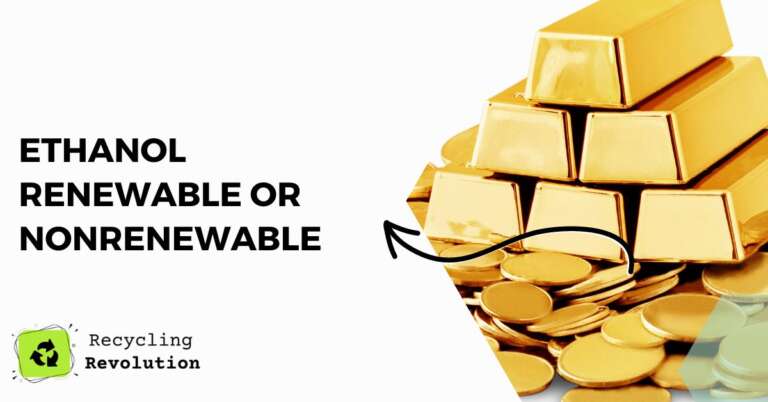If you’ve ever held a piece of gold in your hands, it’s hard not to be captivated by its shimmer and weight. But have you ever stopped to think, “Is gold renewable or nonrenewable?” It’s a question that can offer profound insights into our relationship with this precious metal. Stick around as we dive into this glistening topic.
TL;DR: Gold is a nonrenewable resource. It’s created in unique cosmic events and, once extracted, cannot be replenished in human time scales. However, it’s infinitely recyclable.
The Origin of Gold
Before answering the big question, it’s essential to understand where gold comes from. Contrary to popular belief, it’s not some magical process from the Earth’s core. Gold is formed in the universe’s vast expanse.
The most accepted theory among scientists is that gold originates from the collisions of neutron stars. These are the remnants of giant stars that have gone supernova.
When they collide, they produce a cataclysmic event, spewing out a myriad of heavy elements, gold being one of them. This material eventually finds its way to form planets, including Earth.
Note: While there are other theories about gold’s formation, the neutron star collision is the most scientifically accepted.
Understanding Renewable vs. Nonrenewable
To understand if gold is renewable or not, we need to break down the terms:
- Renewable resources: These are natural resources that can replenish themselves over short time spans, even if they are consumed. Examples include wind, solar energy, and timber.
- Nonrenewable resources: These are resources that don’t regenerate within a human’s lifespan once they’ve been consumed. Think oil, coal, and yes, gold.
Gold, like other metals, exists in a fixed amount in our planet. Once it’s mined and extracted, there isn’t a mechanism for the Earth to create more of it, especially within human timescales.
Gold’s Infinite Recyclability
Here’s a fascinating twist: while gold is nonrenewable, it’s infinitely recyclable. Gold does not degrade over time, meaning its quality doesn’t diminish with reuse.
This is why a significant portion of the gold we use today has been recycled from previous items. From ancient coins to modern-day electronics, gold’s journey is cyclical.
I recommend that for those considering gold as an investment or for personal use, always lean towards recycled gold. It’s an environmentally friendly choice that reduces the need for new mining.
The Environmental Impact of Gold Mining
It’s essential to address the elephant in the room: gold mining’s environmental impact. Mining activities, especially open-pit mines, can cause deforestation, loss of biodiversity, and the introduction of toxic chemicals into the ecosystem.
Note: The use of mercury and cyanide in gold mining can contaminate water supplies and harm both aquatic and terrestrial life.
This is why, beyond the question of renewability, there’s a moral imperative to ensure that the gold we consume is sourced responsibly.
Future of Gold: What Lies Ahead
With advances in technology, there’s the potential to ‘mine’ gold from unconventional sources. For instance, there’s talk about extracting gold from seawater or asteroids. However, the cost, both financially and environmentally, of these ventures remains a significant barrier.
In the interim, I recommend looking at gold not just as a shiny object but as a finite resource that deserves our respect and prudent management.
The Lifecycle of Gold
Gold has a lifecycle that’s unlike many other minerals or metals.
Formation and Deposit
As touched upon earlier, the origins of gold lie in the cosmos. When this gold dust, produced from ancient cosmic events, finds its way to forming planets like Earth, it gets integrated into the planet’s crust.
Over time, geological processes like volcanic activity, erosion, and plate tectonics concentrate these gold particles into deposits, which can be in veins, alluvial deposits, or even embedded within other minerals.
The Mining Process
Gold mining can take on several forms:
- Placer mining: This method involves searching for gold in river sediments. Historically, gold panning was a form of placer mining.
- Hard rock mining: This is the most common method where gold is extracted from rock. It usually involves creating underground tunnels or open pits to access the gold deposits.
- By-product mining: In this method, gold is not the primary target. Instead, it’s recovered as a by-product from mining other metals like copper.
Each mining method has its environmental challenges, and sustainable practices are essential.
Processing and Refining
Once mined, gold ore needs to be processed and refined to extract pure gold. This involves crushing the ore into a fine powder, then treating it with various chemicals, often including cyanide, to release the gold particles. These particles are then collected and further refined to produce pure gold bars.
Note: It’s worth mentioning that for every ton of gold ore mined, only a small amount of actual gold is extracted. The rest is often waste material that needs careful management to prevent environmental damage.
Gold’s Role in Technology and Medicine
Beyond jewelry and finance, gold plays an indispensable role in modern technology and medicine:
- Electronics: Gold’s exceptional conductivity and resistance to corrosion make it ideal for various electronic applications, from connectors in your smartphone to components in high-tech spacecraft.
- Medicine: Gold particles are used in certain diagnostic procedures and treatments. For instance, colloidal gold is used in rapid diagnostic tests, while gold isotopes are employed in some cancer treatments.
I recommend that before discarding old electronics, consider recycling programs. Not only does this reduce electronic waste, but it also aids in the recovery of valuable materials like gold.
Gold as an Economic Indicator
Gold isn’t just a shiny metal; it has profound implications for global economies. Traditionally seen as a ‘safe haven’ asset, gold prices often rise during economic downturns when investors seek safer investments.
Conversely, when economies are booming, and riskier assets offer better returns, gold prices can stabilize or decrease.
Understanding the economic dynamics of gold can offer insights into global economic health and investor sentiment.
The Ethics of Gold
It’s impossible to discuss gold without addressing the ethical concerns surrounding its production:
- Child labor and poor working conditions: Many small-scale mining operations, particularly in developing nations, have been criticized for exploiting child labor and subjecting workers to dangerous conditions.
- Conflict gold: Just like ‘blood diamonds’, there’s ‘conflict gold’ – gold sourced from areas of armed conflict and sold to perpetuate the fighting.
- Environmental degradation: Beyond the immediate environmental impact of mining, the vast amounts of water used in gold processing and potential for chemical spills pose significant environmental risks.
For the ethically-minded consumer, I recommend purchasing only from sources that can certify their gold as conflict-free and sourced following responsible mining practices.
Innovations in Gold Production
As with many industries, technology is paving the way for more sustainable gold production:
- Green mining technologies: These aim to reduce the environmental footprint of mining operations, from energy-efficient machinery to biotechnologies that can ‘eat away’ at gold ore to release the metal.
- Urban mining: With the vast amounts of electronic waste produced every year, some companies are turning to ‘urban mining’ – extracting gold and other precious metals from discarded electronics.
By supporting these innovations, consumers and investors can play a role in ensuring that the gold industry evolves in a direction that’s both profitable and sustainable.
Conclusion
Gold is a special kind of treasure that comes from star explosions far away in space. It’s not something we can make more of, which makes it nonrenewable. But the cool thing about gold is that we can keep using it over and over again without it wearing out.
We need to be careful about how we take gold from the Earth because digging it up can hurt our planet. If we use old gold in new ways, we can make sure there’s enough to go around for a very long time. So, when we talk about gold, remember it’s not just about shiny jewelry; it’s about taking care of the Earth and being smart with what we find.
FAQs
Is gold mining harmful to the environment?
Yes, especially when done irresponsibly. Gold mining can lead to deforestation, loss of biodiversity, and water contamination.
Can gold be created artificially?
While gold can be produced in nuclear reactors and particle accelerators, the process is prohibitively expensive and not practical for large-scale production.
Why is gold so valuable?
Gold’s value is derived from its rarity, its unique properties like malleability and resistance to tarnish, and its historical significance in cultures worldwide.
Can we ever run out of gold?
Technically, yes. But with recycling and the vast amounts still unmined in the Earth, it’s unlikely we’ll run out anytime soon.

